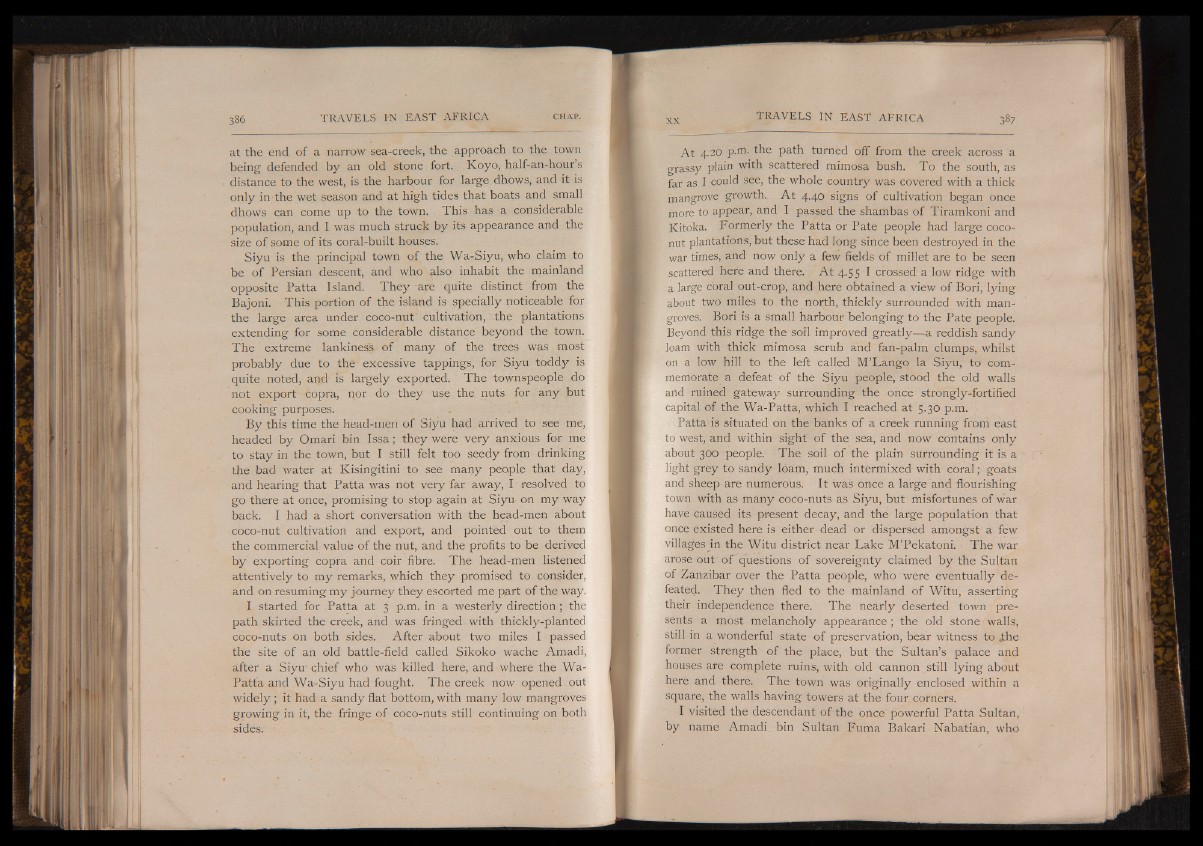
386
at the end of a narrow sea-creek, the approach to the town
being defended by an old stone fort. Koyo, half-an-hour s
distance to the west, is the harbour for large dhows, and it is
only in the wet season and at high tides that boats and small
dhows can come up to the town. This has a considerable
population, and I was much struck by its appearance and the
size of some of its coral-built houses.
Siyu is the principal town of the Wa-Siyu, who claim to
be of Persian descent, and who also inhabit the mainland
opposite Patta Island. They are quite distinct from the
Bajoni. This portion of the island is specially noticeable for
the large area under coco-nut cultivation, the plantations
extending for some considerable distance beyond the town.
The extreme lankiness of many of the trees was most
probably due to the excessive tappings, for Siyu toddy is
quite noted, and is largely exported. The townspeople do
not export copra, nor do they use the nuts for any but
cooking purposes.
By this time the head-men of Siyu had arrived to see me,
headed by Omari bin Issa; they were very anxious for me
to stay in the town, but I still felt too seedy from drinking
the bad water at Kisingitini to see many people that day,
and hearing that Patta was not very far away, I resolved to
go there at once, promising to stop again at Siyu on my way
back. I had a short conversation with the head-men about
coco-nut cultivation and export, and pointed out to them
the commercial value of the nut, and the profits to be derived
by exporting copra and coir fibre. The head-men listened
attentively to my remarks, which they promised to consider,
and on resuming my journey they escorted me part of the way.
I started for Patta at 3 p.m. in a westerly direction ; the
path skirted the creek, and was fringed with thickly-planted
coco-nuts on both sides. After about two miles I passed
the site of an old battle-field called Sikoko wache Amadi,
after a Siyu- chief who was killed here, and where the Wa-
Patta and Wa-Siyu had fought. The creek now opened out
widely; it had a sandy flat bottom, with many low mangroves
growing in it, the fringe of coco-nuts still continuing on both
sides.
At 4.20 p.m. the path turned off from the creek across a
grassy plain with scattered mimosa bush. To the south, as
far as I could see, the whole country was covered with a thick
mangrove growth.. A t 4.40 signs of cultivation began once
more to appear, and I passed the shambas of Tiramkoni and
Kitoka. Formerly the Patta or Pate people had large coconut
plantations, but these had long since been destroyed in the
war times, and now only a few fields of millet are to be seen
scattered here and there. At 4.55 I crossed a low ridge with
a large coral out-crop, and here obtained a view of Bori, lying
about two miles to The north, thickly surrounded with mangroves.
Bori is a small harbour belonging to the Pate people.
Beyond this ridge the soil improved greatly— a reddish sandy
loam with thick mimosa scrub and fan-palm clumps, whilst
on a low hill to the left called M’Lango la Siyu, to commemorate
a defeat of the Siyu people, stood the old walls
and ruined gateway surrounding the once strongly-fortified
capital of the Wa-Patta, which I reached at 5.3O p.m.
Patta is situated on the banks of a creek running from east
to west, and within sight of the sea, and now contains only
about 300 people. The soil of the plain surrounding it is a
light grey to sandy loam, much intermixed with coral; goats
and sheep are numerous. It was once a large and flourishing
town with as many coco-nuts as Siyu, but misfortunes of war
have caused its present decay, and the large population that
once existed here is either dead or dispersed amongst a few
villages in the Witu district near Lake M’Pekatoni. The war
arose out of questions of sovereignty claimed by the Sultan
of Zanzibar over the Patta people, who were eventually defeated.
They then fled to the mainland of Witu, asserting
their independence there. The nearly deserted town presents
a most melancholy appearance; the old stone walls,
still in a wonderful state of preservation, bear witness to ¿he
former strength of the place, but the Sultan’s palace and
houses are complete ruins, with old cannon still lying about
here and there. The town was originally enclosed within a
square, the walls having towers at the four corners.
I visited the descendant of the once powerful Patta Sultan,
by name Amadi bin Sultan Fuma Bakari Nabatian, who